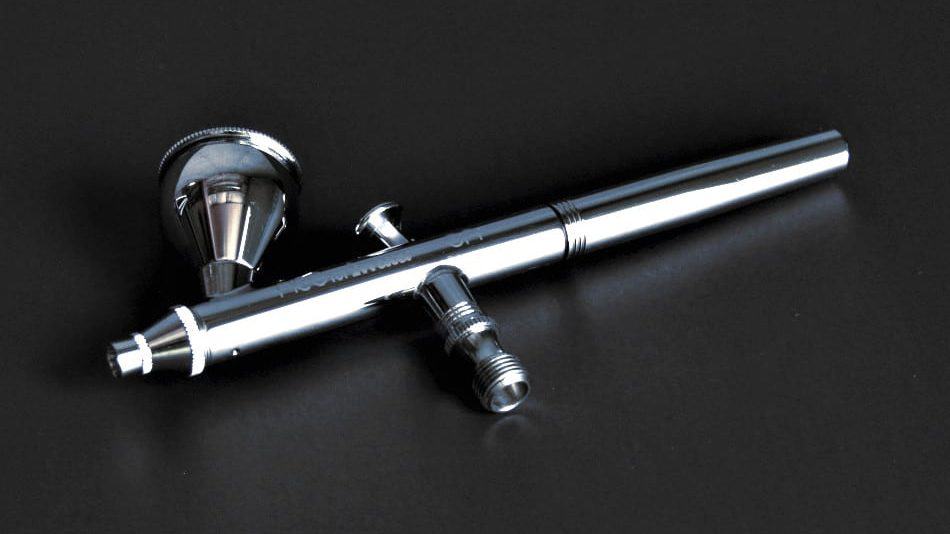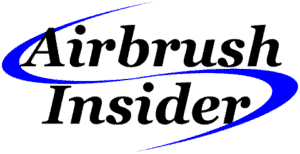Let’s be real, there are a plethora of cheap airbrushes on the market today, and while there are a multitude of different factors to consider when selecting an airbrush, cost very likely may be at the top.
Which is totally fine, especially if your a complete beginner just looking to get your feet wet with a budget friendly airbrush.
To be honest, when I initially took up airbrushing I wasn’t sure I was suited to work with an airbrush, so to minimize the financial loss (Assuming I didn’t follow through with it) I went with cheaper equipment to start.
If you opt to do the same, there is absolutely nothing wrong with that, you can always upgrade your equipment later, as I did.
Honestly speaking, I actually recommend people go the cheaper route to start.
Simply because it’s much more cost effective to learn on cheaper equipment rather then expensive high-end equipment. As an airbrush is a delicate tool, that can easily be damaged without the proper education and experience.
That being said, I spent a significant amount of time in my early days studying the cheaper airbrushes on the market to find one for myself.
I wanted all the traits of a high end airbrush:
- Quality
- Longevity
- Versatility
- Performance…
But without the associated cost.
Saying I was on a mission to find the best budget airbrush for myself was an understatement…
Were my expectations alittle out there? You could say that…
But believe it or not, I actually found an airbrush that checked all the boxes! And to give you one better it’s priced far below $100 dollars (USD)!
My Top Budget Airbrush Pick!
I’ll be honest with you, I’m a big believer in the old saying:
You get what you pay for
And when it comes to airbrushes, there is absolutely no exception.
Airbrushes require tight tolerances in order to operate flawlessly and reliably. So finding one that is easy on the walet, but built well proved to be quite difficult to say the least…
But I believe I found an option well worth your consideration. I have been happy with it since the day I bought it!
Introducing The Iwata Neo Airbrush!

Iwata, arguably the most well known airbrush manufacturer within the industry. Iwata has been in the airbrush game since 1982 producing some of the best airbrush equipment available on the market!
Within the last few years, they introduced a revolutionary budget airbrush to their already strong assortment of high-end airbrushes.
That being the Iwata Neo (Available on Amazon).
The Neo was a hit the moment it came out. There are videos, and mentions all over the internet touting, Neo for the win.
Just like I’m about to do…
Don’t get me wrong, the Neo does have it’s quirks as does anything. But when it comes to evaluating it from a cost to value standpoint, the Neo Is definitely a win!
I thought so when I initially bought it a little over a year ago, and now looking back on the year i’ve spent owning and operating it I’m even more convinced its the best budget airbrush on the market today!
Here’s Why:
1st: The Neo Is A “Double Action” Airbrush!

Which means you can control the paint intensity with a slight movement of your trigger finger.
Need more paint? Great, pull back further on the trigger.
Need Less? Don’t pull back as far…
Simple, but highly effective!
The double action design is what is used on the higher-end airbrushes, simply because it gives much greater control to the user compared to its counterpart, the Single Action airbrush.
Comparing a Double Action airbrush to a Single Action airbrush is like comparing a detailed, colorful painting, to a pencil sketch. There is really no comparison, aside from the similar shape.
Simply put, A Double Action airbrush is far superior to a Single Action airbrush, period.
2nd: Multiple Paint Feed Options Available!
To give you one even better, the neo is available in a few different feed types:
- Gravity Feed
- Siphon Feed
But what does this mean??
Well, you need a small onboard paint storage correct? Well…
The Gravity Feed Neo Explained
The gravity feed Neo airbrush commonly known as Iwata Neo CN (Available on Amazon), essentially locates the paint cup in a funnel shaped cup on top of the airbrush. This method is exquisit for minimizing air pressure requirements, and maximising paint atomization at low PSI.
Get this, the gravity feed Neo’s optimal operating pressure. Meaning the PSI level that is best suited for the gravity feed Neo is a miniscule 20 PSI! At only 20 PSI, you won’t be putting much demand on your air compressor, if any!
Plus the Gravity feed edition of the Neo comes with 2 different sized paint cups that easily thread on and off. Giving you even more options to choose from to better setup the airbrush to fit your style!
The Gravity Feed Neo is the one I personally own, and I couldn’t be happier with it for the price. Now, the siphon feed I haven’t got much experience with…
The Siphon Feed Neo Explained
The siphon feed Neo airbrush commonly known as: Iwata Neo BCN (Available on Amazon), basically locates the paint cup (Or bottle in this case) underneath the airbrush in a 1 oz bottle.
The siphon feed Neo works wonders for large paint projects that will require a significant amount of paint. Simply because the siphon feed airbrush bottle can hold 4 – 5 times the amount of paint a gravity feed airbrush can.
The only downside to the Siphon feed Neo is it requires a minimum of 20-25 PSI to simply function semi decent.
Ideal operating pressure is more north of 30 – 40 PSI (Based on my experience with siphon feed airbrushes). Simply because the paint needs to be “siphoned” up from underneath the airbrush into the atomization chamber, where as the gravity feed simply utilizes gravity to get paint in the atomization chamber.
Personally speaking, I’m a big fan of the Iwata Neo CN (The gravity feed edition of the Neo). Simply because it requires much less PSI to operate. Which means, much less strain on your air compressor over time.
Which then translates to more available use out of your air compressor.
3rd: Neo’s Tip Size Is Highly Versatile

What do I mean by “Tip Size”?
Simply put, the tip size is the size of the needle and nozzle combo inside the airbrush. You see, the smaller the Needle & Nozzle (Tip size), the finer the line your able to achieve and vice versa.
Think of it like this:
- Smaller tip size = Thinner line width.
- Larger tip size = Thicker line width.
A smaller tip size is ideal if you intend on airbrushing a lot of fine detail, A larger tip size is ideal if your simply airbrushing for coverage.
The wonderful part about the Iwata Neo CN tip size, being that it is a 0.35millimeter tip size is that it is essentially right smack in the middle of commonly available airbrush tip sizes.
Which makes it highly versatile and able to achieve both fine detail and coverage well!
4th: Neo Nozzle Attachment Method (My One Gripe)
I know, I’m supposed to be touting how great the Neo is, as it is my favorite budget airbrush. But to be completely honest, it does have a minor flaw worth mentioning.
The one drawback I have with the Neo is the fact that it has a threaded nozzle rather then a press fit nozzle.
Which means the Nozzle (Part of the tip section) threads onto the body of the airbrush, rather than press-fits, as a majority of the higher-end airbrushes do.
But I guess you can’t have it all…
Don’t get me wrong, there is no hindrance to usability and / or performance. This flaw simply allows for slight greater risk of damaging the airbrush during disassembly and reassembly.
The Issue with the threaded on nozzle design is it makes it easy to over tighten the nozzle, likely stripping the threads, or even shearing them off completely.
That being said, as long as you are careful not to over tighten it, this will never pose an issue.
It never has for me, and i’ve been using the airbrush for over a year now.
Nonetheless, If by chance you were to over tighten the nozzle, damaging the nozzle. You can get a new one for somewhere around $10 dollars (USD). Click the link to see current pricing on a new Iwata Neo CN Nozzle on Amazon.
Bonus Budget Airbrush Worth Your Consideration!
Back in the day, when I was scavenging the internet for the best cheap airbrush for myself to start my airbrush endeavor. I had a list built out of the top 5 budget airbrushes to compare specs on.
I had it whittled down to the Iwata Neo (as discussed above) and another that was developed by one of Iwata’s largest competitors…
Introducing the Badger 105 Patriot
Badger, Not quite the largest name in the airbrush industry, but making its way there. Badger has been in the game for decades, and though they aren’t at the top, they are close.
One big thing about the Badger brand is, it’s an american made company specializing in airbrush equipment!
The Badger 105 Patriot (Available on Amazon), like the Neo, Is a double action airbrush. However it is only available as a gravity feed (as of the time of this writing). But that’s the option most will go for anyway. So, no big deal there.
Badger 105 Patriot is a solid option in terms of cost to value, that’s why it was 2nd on my list.
It just didn’t quite meet my needs.
You see, I wanted a versatile airbrush. Which meant I could do both semi fine detail as well as smooth, effortless coverage.
The Badger has coverage handeled with its 0.5mm tip size (Needle & Nozzle size) but when it comes to detail. 0.5mm is just to large…
That’s the only reason i went with the Neo over the Patriot. That being said, if your airbrushing miniatures / models. Or you intend on doing airbrushed makeup for cosmetic purposes?
The Badger 105 Patriot will likely fit your needs better then the Iwata Neo. As those styles of airbrush work don’t commonly require fine detail.
Simply evaluate the style of artwork you intend on doing. The Badger 105 Patriot just might work better for you and your intentions!
Conclusion
The Iwata Neo CN (See Pricing On Amazon) is my all time favorite budget airbrush simply because it far exceeds my standards, and for the price it just can’t be beat.
To give you one better, I recently upgraded my main airbrush to an Iwata Eclipse HP-CS (which is valued at over $150) yet surprisingly, the Neo competes with it.
I mean, the Eclipse pulls a slight better line, but the Neo feels just like the Eclipse in my hand.
It’s just as responsive. To be honest, the Neo feels a little more nimble then the Eclipse.
Which I never would have thought would be the case… But…
Anyway, I truly believe the Neo is the best budget airbrush today, and likely will be for years to come!
That being said,
There are many cheap airbrushes flooding the market today, and If you opt to go an alternative route than the Neo, or Patriot do so strategically…
I hope you were able to find some value here! If you have any further questions regarding the airbrush do be sure to take a look around the website. Airbrush Insider is dedicated to helping all in the airbrush community!
This is Colt signing off!
Check Out Some Of My Favorite Airbrush Equipment:

